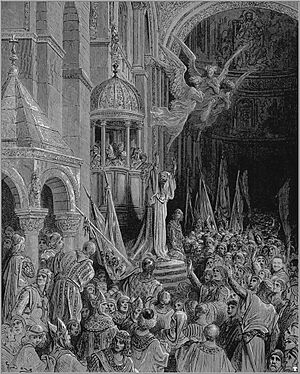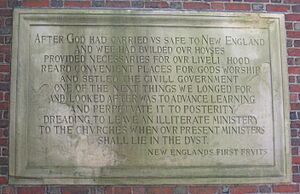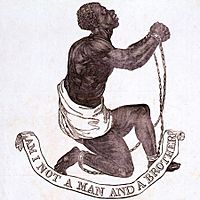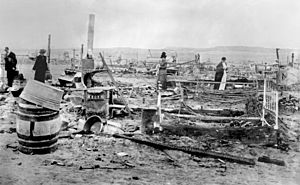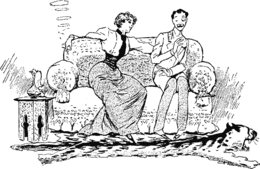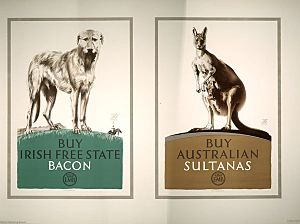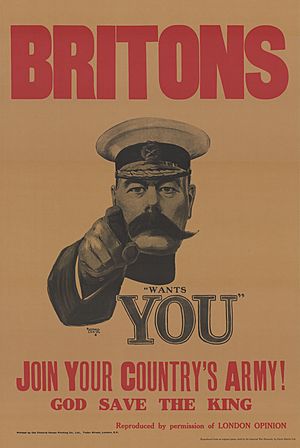History of public relations facts for kids
Public relations (PR) is a way of managing how information about a person or organization is shared with the public. It's all about building a good image and strong relationships. Many people say the modern PR profession started in 1900 with the "Publicity Bureau." But even before that, people used different ways to influence others and manage communication throughout history. In Britain, Basil Clarke is seen as the founder of PR, starting Editorial Services in 1924. Before that, religious groups and reformers, especially those against slavery, used PR methods to spread their messages.
During World War I, both sides used propaganda to get support at home and make their enemies look bad. In the 1920s, PR experts started working for private companies. Public relations first became big in the U.S. thanks to people like Ivy Lee and Edward Bernays, and then it spread around the world. After 1948, many American companies opened branches in Europe, helping PR grow there too.
The second half of the 20th century was a time of big growth for PR. Trade groups, magazines, international agencies, and academic ideas for the profession were created. In the early 2000s, companies started using social media for press releases. A book called The Cluetrain Manifesto in 1999 predicted how social media would change things, and by 2006, everyone agreed it was a big deal.
Contents
Ancient Ways of Influencing People
Even though the term "public relations" didn't exist, experts say ancient civilizations used early forms of influencing people and managing messages. Edward Bernays, a PR pioneer, said that the main parts of PR—informing, persuading, or connecting people—are as old as society itself.
For example, an old clay tablet found in Iraq, which shared tips for better farming, is sometimes called the first PR example. Ancient leaders in Babylon, Egypt, and Persia built huge pyramids, tall monuments, and statues to show they had a special right to rule. They also claimed to have magic or religious power to convince people they were meant to be leaders.
Ancient Greek cities had very skilled speakers, known as "sophists." While some, like Plato, thought sophists were dishonest, others believed they used good ways to persuade people. In Egypt, advisors helped pharaohs speak honestly, and scribes wrote down their achievements. In Rome, Julius Caesar wrote the first campaign biography to promote his military wins. He also ordered newsletters and poems to support his political ideas. In medieval Europe, craftspeople formed guilds to manage their group's reputation.
Pope Urban II's efforts to recruit people for the crusades are also sometimes called an early PR campaign. Later, Pope Gregory XV created the word "propaganda" when he started a group to spread Christianity using trained missionaries. The word "propaganda" didn't become negative until it was linked to government publicity during World War II.
Early Influencers and Movements
Explorers like Christopher Columbus and Ferdinand Magellan used exciting, sometimes exaggerated, stories to get settlers to come to the New World. For instance, in 1598, Captain Arthur Barlowe described a swampy area of Virginia as "the most plentiful, sweet, fruitful and wholesome of all the world." When colonists wrote back about the tough times in Virginia, anonymous pamphlets were shared to calm fears and encourage more settlers.
The first newsletter and daily newspaper started in Germany in the early 1600s. In France, Cardinal Richelieu used pamphlets to support his policies and attack his rivals. The French government also created a publicity office and a weekly newspaper. During the English Civil War in the mid-1600s, both sides used pamphlets to argue for or against the monarchy.
In 1641, Harvard University sent three preachers to England to raise money for missionary work. To help, the university made one of the first fundraising brochures, New England's First Fruits. King's College (now Columbia University) sent out an announcement for its 1758 graduation, and newspapers printed the news, which was an early form of a press release. Princeton University was the first to regularly send news about its activities to newspapers.
More organized PR began as people started forming groups for social and political changes. In England, the Society for Effecting the Abolition of the Slave Trade started in 1787. It published books, posters, and held talks against slavery. Industries that relied on slavery tried to convince people that it was necessary. The slave trade was stopped in 1807. In the U.S., the movement to end slavery began in 1833, using methods from the British movement like petitions, pamphlets, and boycotts. The South defended slavery using economic and religious arguments.
The Boston Tea Party is sometimes called a "public relations event" because it was a planned action meant to influence the public. Pamphlets like Common Sense were used to spread anti-British ideas in the United States. After the American Revolution, disagreements about the U.S. Constitution led supporters to send letters, now called the Federalist Papers, to newspapers to gain public support.
In the 1800s, PR was more spontaneous. To counter French ideas that American democracy was chaotic, the Marquis de Lafayette, who helped fund the American Revolution, was invited on a U.S. tour. Each town he visited created a committee to welcome him and promote his visit. Later, P. T. Barnum became famous for promoting his circus using clever, sometimes tricky, methods.
In the 1860s, railway companies building the Transcontinental Railroad used "sophisticated corporate public relations" to raise money. They needed to look good to investors, politicians, workers, and journalists.
Early environmental groups formed in the late 1800s. Many common PR practices today, like interviews and press conferences, started then. Companies began to care about their public image. The German company Krupp created the first corporate press department in 1870. The first U.S. corporate PR department was set up by Westinghouse Electric Corporation in 1889. The term "public relations" first appeared in a railway book in 1897.
PR Becomes a Profession
Many experts agree that public relations began as a paid profession around the early 1900s. While its exact start date is debated, it developed over time. Most books say PR started in the U.S. and then spread, but some say it developed in the UK and U.S. at the same time. In Europe, PR activities didn't really start as a profession until the 1920s.
In the early 1900s, many newspapers and magazines wrote articles criticizing big businesses. People became very critical of large companies. Public relations was partly created to defend businesses against these critical news stories. It also helped promote buying goods after mass production became common.
Early Pioneers of PR
The Publicity Bureau was the first PR agency, started by former journalists, including Ivy Lee. Ivy Lee is often called the "father of PR." In 1906, Lee published his "Declaration of Principles," saying that PR work should be open, accurate, and focus on public interest. This marked a shift towards informing, rather than misleading, the public. Lee also helped create the modern press release and the idea of a "two-way street" – listening to and talking with the public.
In 1906, Lee helped the Pennsylvania Railroad get good media coverage after a train accident by inviting reporters to the scene, which was unusual at the time. However, Lee's work was sometimes seen as "spin" or propaganda. For example, after the Ludlow Massacre in 1914, where striking miners were killed, Lee published misleading information on behalf of the Rockefeller family. Lee advised the Rockefellers to meet with miners and their families, listen to their concerns, and show they cared, which helped improve their public image.
Edward Bernays, a nephew of Sigmund Freud, is also called a "father of PR" for his work in the 1920s. He believed that audiences needed to be understood and persuaded. He wrote the first PR textbook and taught the first college course on PR in 1923. Bernays used ideas from psychology and sociology to manage public thinking.
In 1929, Edward Bernays helped the Lucky Strike cigarette brand sell more to women. He found that women didn't like the green color of the cigarette packs. So, Bernays convinced fashion designers and others to make green popular. He also linked cigarettes to "Torches of Freedom," suggesting that smoking was a way for women to show independence.
Both Lee and Bernays had great success in making PR a respected field. However, later in their careers, they took on clients with questionable values, which led to public criticism. Walter Lippmann also contributed to early PR ideas, suggesting that public opinion could be shaped by experts.
Basil Clarke is considered the founder of PR in the UK. He started the UK's first PR agency in 1924 and wrote the world's first code of ethics for the field in 1929. He believed PR must be true and complete to be trusted.
Arthur W. Page is often called the "father of corporate public relations" for his work with AT&T from 1927 to 1946. AT&T was facing public resistance to its efforts to become a monopoly. Page helped improve the company's image by presenting it as a public service and highlighting its contributions to society.
Early PR Campaigns
In the early 1920s, Edward Clarke and Bessie Tyler helped the Ku Klux Klan grow to four million members using publicity methods. In 1926, the British government formed the Empire Marketing Board to encourage people to buy British goods.
Presidents Franklin Delano Roosevelt and Woodrow Wilson were the first to really use publicity. In the 1930s, Roosevelt used the media to promote his "New Deal" programs and blame corporations for economic problems. This led companies to hire their own publicists to defend themselves.
During World War II, Coca-Cola promised that every soldier could get a bottle for five cents, no matter where they were. The company convinced politicians that it was vital to the war effort and was allowed to get sugar even when it was rationed. After 1948, as American companies expanded into Europe, PR became more common there.
In 1938, De Beers, a diamond company, worked with an advertising agency to link diamonds with romance. They wanted people to believe that "the larger and finer the diamond, the greater the expression of love." This campaign was very successful in convincing people to buy expensive diamonds during tough financial times. It also led to the famous slogan "A diamond is forever" in 1947.
Wartime Communication
World War I
The first big, organized propaganda campaigns happened during World War I. Germany created a bureau to make pamphlets and books to support their cause, encourage people to join the army, make the enemy look bad, and keep America neutral. Britain and France also created their own propaganda agencies. Stories of terrible acts, real or fake, were used to make people hate the enemy.
After the U.S. joined the war in 1917, President Woodrow Wilson set up the Committee on Public Information (Creel Commission). This group spread positive messages about the war and denied false stories meant to anger people. They recruited 75,000 "Four Minute Men" who were volunteers who gave short speeches about the war at social events.
Because of World War I propaganda, PR ideas shifted from just using facts to focusing on emotions and how crowds think. The word "propaganda," which used to be linked to religion, became more widely known.
World War II
The word "propaganda" got a negative meaning because of how it was used in Nazi Germany during World War II. Adolf Hitler believed that better British propaganda was a main reason Germany lost World War I. In March 1933, the Nazis created the Ministry of Public Enlightenment and Propaganda. The Nazi party took control of newspapers, created their own news groups, and used posters, films, and books to spread their messages.
During the war, radio became the most important way to spread propaganda. Posters were used at home, and leaflets were dropped behind enemy lines. In areas conquered by Germany, people could be punished by death for listening to foreign radio. British propaganda was very careful about understanding its audiences in different countries. U.S. propaganda focused on fighting for freedom and linking war efforts to industrial production.
Growth of the Profession
By the 1940s, public relations was being taught at universities and was seen as a professional job, like being a lawyer or doctor. However, it didn't fully gain recognition as a profession partly because of its history of sometimes being misleading.
More media outlets appeared, and PR experts from wartime propaganda moved into the private sector. Public relations became common for political, activist, and corporate goals. As media became faster, PR activities and the people they represented faced more scrutiny. For example, President Richard Nixon was criticized for his PR office's responses during the Watergate scandal.
Trade associations for PR were formed, starting with the Public Relations Society of America (PRSA) in the U.S. in 1947, and then the Institute of Public Relations in London in 1948. Similar groups were created in other countries. The International Association of Public Relations was founded in 1955. Betsy Ann Plank is known as "the first lady of public relations" because she was the first female president of the PRSA in 1973.
Two of today's largest PR firms, Edelman and Burson-Marsteller, were founded in the 1950s. Daniel Edelman created the first media tour in the 1950s. Trade magazines like PR Week also started during this time. John Hill, founder of Hill & Knowlton, was a pioneer in international PR, creating a strong global network in the 1960s and 1970s. Other firms followed, expanding PR around the world.
In the 1980s, public relations grew from just "press agents" to a field with its own theories and practices. Research was published in academic journals. This led to a common way of doing PR work, often described as a four-step process: research, planning, communication, and action.
Social and Digital PR
In the 1990s, PR started to specialize in communicating with specific groups or within certain markets, like investor relations. New internet technology and social media websites changed PR strategies. In 1999, a group of managers created "The Cluetrain Manifesto," which had 95 ideas about how social media and the internet would change business. It said that markets had become "smarter and faster than most companies" because people were getting information from each other. This idea was controversial at first, but by 2006, it was widely accepted that social media played a big role in public relations.
See also
 In Spanish: Historia de las Relaciones Públicas para niños
In Spanish: Historia de las Relaciones Públicas para niños


